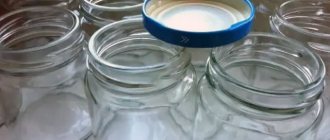Canned foods are indispensable not only at home, but also in other situations. They can come in handy while hiking, picking berries, hunting or in the country. Moreover, it often happens that there are no special tools for opening cans. In this case, there is no need to worry, because there are many ways to solve this problem.
Pocket knife
The packaging is made from a thin sheet of tin that can be easily cut with a regular knife. In this case, you will need very little effort, and the contents of the jar will remain intact. To do this you should:
- Place the jar on a flat surface and place the tip of the knife over the inner rim of the lid.
- It is necessary to hold the knife strictly in a vertical position and in no case at an angle. To avoid injury, you should hold the handle firmly.
- Next, lightly tap the handle of the device with the fist of your free hand. This will allow the tip of the knife to pass through the metal. The blow should not be too powerful so that the tool does not jump out of your hands.
- Then you need to move the tip a few centimeters along the edge and make another hole. So you need to go along the entire border of the lid.
- Next, the tip of the knife is passed through one of the recesses and the lid is carefully bent upward.
Since the edges of the metal are sharp, it is better to protect your hands with a towel when bending the lid.
Classic version
- put the condensed milk on the table, press the sharp end of the opener to the top of the can and hit its handle with your hand, a hole will appear
- insert the point into the resulting hole
- hold the can with one hand and the handle of the opener with the other
- move slowly up and down in a circle
- pick up the lid with the tip of the opener and gently pull up.
You can use a simpler method and use the edge of a canned knife to make a hole in the lid, then you can simply drink the liquid or pour it directly from the hole. Just be sure to make a second hole in parallel to maintain pressure in the jar.
But it may happen that when you went to nature or to the country, you forgot to take the bottle opener with you. How to open condensed milk if the necessary device is not at hand? You can use other simple methods to open a tin container.
Bare hands
There are times when there are no objects nearby at all. In this situation, you have to rely only on your own hands. The method will only work for a strong and physically fit person:
- Hold the jar between your palms. In this case, it should be located horizontally. Make a dent in the center of the side with your fingers. Then you need to press again on the resulting depression so that the metal bends inward even more.
- The same steps must be repeated on the other side.
- Now you should take both bottoms with your palms and make uniform rotational movements towards each other. The deflection area should crack. The jar can be divided into two halves.
The bare-hand method is suitable if there is not a large amount of brine or oil inside the jar.
How to open a jar without an opener
Preservation in glass jars has two types of lids:
- Twist - usually found on purchased products and used in production (Figure 1);
- Simple ones or those that need to be rolled up - housewives use them for homemade pickles.
Figure 1. Two types of lids: screw-on and seaming
Let's start with how to open a jar with a lid without an opener, if it is purchased:
- Just pry off the screw cap with a knife and let air under it;
- When a characteristic pop is heard, turn the lid and your food will be ready to eat;
- If you don’t have a knife, hit it with something from above so that it slams - with your elbow, a rolling pin or a rubber mallet.
How to open a jar without an opener if it is rolled up at home:
- Use the knife again - mark a tick or the letter "l" on the lid so that the corner and ends of your daw rest against the edges;
- Insert the cutting tool into the drawing and cut the tin along the marked lines;
- Then bend its sharp corner and pick it up with a knife, winding the cut part around it until the very end (Figure 2);
- Carefully remove the remaining tin so as not to cut your hands.
Figure 2. Opening homemade preserves with a knife
Spoon
This method is suitable for those who are afraid of knives. This will require a strong metal spoon, great physical effort and time. The cutlery should be placed in exactly the same way as in the already discussed method with a pocket knife. Next, they begin to rub the lid forward with it until the tin is worn out. After some time, a hole forms in the material. Then the spoon can be used as a knife, opening the jar around the entire perimeter.
You should be careful, as with this method of opening the edges of the can are very sharp and dangerous.
How to open the lid of a jar of homemade preserves
Grandma's compote or mom's sauté can be easily opened without a special key if desired.
At the same time, there is no need to spoil your health and teeth by trying to bend the lid with them or pierce it with a knife.
One method is using pliers:
- Take regular pliers;
- Operate them according to the principle of a familiar bottle opener;
- Work carefully to avoid damaging the glass.
Figure 8. Opening the jar with your elbows
But most representatives of the stronger sex prefer another, proven method:
- The container with pickles is placed on a table or cabinet;
- It’s good if someone is holding her at this moment;
- A sharp movement of the elbow strikes the lid (Figure 8);
- It should bend inward and move away at the edges.
To begin with, it is recommended to practice the blow on the same table in order to understand its strength and reduce the unpleasant sensations and consequences from it to a minimum.
Another effective, but precision-requiring option that will take a little time:
- The dishes are turned over with the twist down and placed on the table;
- Take a knife with a sharp end and bend the lid away from the glass;
- In this case, the second hand applies light pressure on the container itself;
- Movements are performed around the entire perimeter or up to half the circle;
- Then the preservation is turned over, and the lid is removed without any problems;
- You must work very carefully so as not to scratch the glass product or leave a chip on it.
With a chef's knife
For effective work, a knife with a massive blade is suitable. It weighs much more than regular steak cutting tools. The technology for opening a can using this device is as follows:
- Place the container on a table or find another stable surface. For safety reasons, you should not squeeze it between your knees.
- Hold the knife handle firmly in your hand. Make sure your fingers are away from the tip and on the sides of the handle.
- Place the heel (the widest part of the blade) above the inner rim of the can near the side. Firmly secure the heel to the lid so that the knife does not slip during the piercing process.
- Sometimes you can't make a hole the first time. You can stand up, lean on the can, and then press down on it with all your weight.
- You should not hit the container. This method is considered slow but effective.
- It is highly undesirable to use the sharp end of a knife for work. You can not only bend the blade, but also get hurt.
- Move the knife along the edge a few centimeters and make similar holes. The lid is almost open.
- Insert the tip of a knife into one of the slots and point the lid upward.
Why do such banks not want to open?
Twist-off is the name for tin lids for twisting. Their popularity is justified by the possibility of reusable use. They can be held in place not only because of the presence of threads. The principle is very simple: during the preparation of canned food, the can is doused with boiling water or steam, and at this time the polymer coating softens. During the cooling process, the top is drawn inward, and the strength of the twist is ensured by the vacuum effect. This makes it possible to close the seal extremely tightly. By creating a sealed environment, the entry of microbes into the food is prevented; moreover, the products become suitable for consumption for a long time.
To reuse such caps, they must be opened carefully. You can use a special key or unscrew it manually, applying considerable effort. Reasons that prevent opening:
- wet and slippery hands;
- retraction greater than the desired value due to low pressure;
- a jar of honey, preserves or jam may be high in sugar and the lid is simply glued to the neck.
The lid must be unscrewed strictly counterclockwise, as it is screwed in the opposite direction.
Before the unscrewing process itself, it is necessary to inspect the cover. If it is swollen, it cannot be opened. This indicates that the food inside has gone bad. When opened, the cover may fly off and cause injury. You have to be very careful with such a defect.
There is also the possibility of glass getting into the products. If you see chips or cracks, the jar should not be touched. Air is guaranteed to get inside and the contents will deteriorate.
Sandpaper or stone
You can also use asphalt or a concrete block with a rough texture. A polished object will not create the necessary friction to pierce the lid.
The jar is placed on the paper upside down and rubbed with pressure for 30 seconds. The edge of the jar should wear off. The readiness of the product for opening is indicated by the appearance of stripes on the edges. You can also wait for the liquid to appear. The prepared container opens with a simple press of the hand. The lid just flies off. You can find a cobblestone or stick that is convenient to pierce the lid inside the product. This option is effective, but not the best, as metal particles and dirt get into the food.
If microchips or sawdust get in, it is important to remove all debris. Canned food should be opened in sufficient light.
It is difficult to imagine the dynamic life of a modern person without canned food. They allow you to store food for a long time without special conditions. You don't need a bottle opener to open a jar. We hope that the proposed methods and ingenuity will help you not to get confused at the right moment.
Subscribe to our Social networks
Method 3: Without improvised means
If you can’t open a can, but you don’t have any tool at hand, then you can do it even without one.
If you have access to a difficult, slightly abrasive surface like concrete sidewalk, brick, or cliff, you will open a can in 60 seconds.
STEP 1: Loosen the top of the can
The strategy is to use an abrasive surface to loosen the lid of the jar. You'll have to use a little force.
First, place the can from top to bottom on a hard, abrasive surface such as concrete pavement or brick.
Then place your hand on the bottom of the jar. Using slight downward pressure, quickly scrub the top of the jar back and forth as if you were scrubbing a cast iron pan.
Once the top of the can begins to weaken, you may see liquid begin to leak around the edges of the can.
STEP 2: Open the lid
The next step is to remove the cover.
If you have a pair of gloves on hand, they may be helpful to avoid cutting yourself on the sharp edges of the lid while performing this method.
Holding the can right side up, gently squeeze the sides about a couple of centimeters below the top.
If something doesn’t work out right away, then turn the jar and squeeze out the lid.
STEP 3: Enjoy!
Once you have popped the top of the lid, reset it and enjoy your meal.
This is why it is one of the easiest and most effective methods to open canned food without any tools. Now you know how to open a jar not only with a knife, but also without it.
There are also many other methods for opening a can, but these are the simplest and most effective. They say that a hungry person will get to food in any way, even if he does not have a bottle opener at hand. Using these life hacks, you can be sure that you will always be able to open a jar. But it’s still better to have an opener with you so as not to suffer when opening canned food.
Tips for the piggy bank
Another situation is also possible. We decided to enjoy our favorite dessert - honey, jam, confiture, but the jar still does not give up its position.
You turned it over, and bent it, and tapped it, and tried it with a towel. All wrong. Tips don't work? But no!
The reason is simple - the sweet stuff just stuck together. You just need to rinse the lid well, with it closed, in hot water. And the problem will be solved quickly.
By the way, the same thing often happens with children's cough syrups. They freeze tightly, yes, the lid can be plastic.
We take it again and take a hot shower. We do the same with dispensing syringes. Rubber gloves can also be a good way to open a jar; housewives always have them on hand.
The towel still slides, but the rubber doesn’t move anywhere. Some even use sandpaper.
We hope you are now not afraid to buy food in cans for work or on the road, and especially not throw away syrups, since they cannot be opened at the right time.
A simple way to treat containers with potassium permanganate
Pre-prepare a solution of potassium permanganate, saturated in color.
Pour the solution into the washed containers, filling the entire volume by half. Add warm water to the rim of the jar.
Cover with a lid and let stand for 10 minutes. Turn the closed jar over and keep it like that for about 5 minutes. As a result, it will be possible to get rid of microorganisms living on the surface of the cans.
This method is reliable and safe, as the risk of scalding is greatly reduced. However, it is not always possible to have the required amount of potassium permanganate in stock. Therefore, the method is not very popular if it is necessary to prepare a large number of products.











